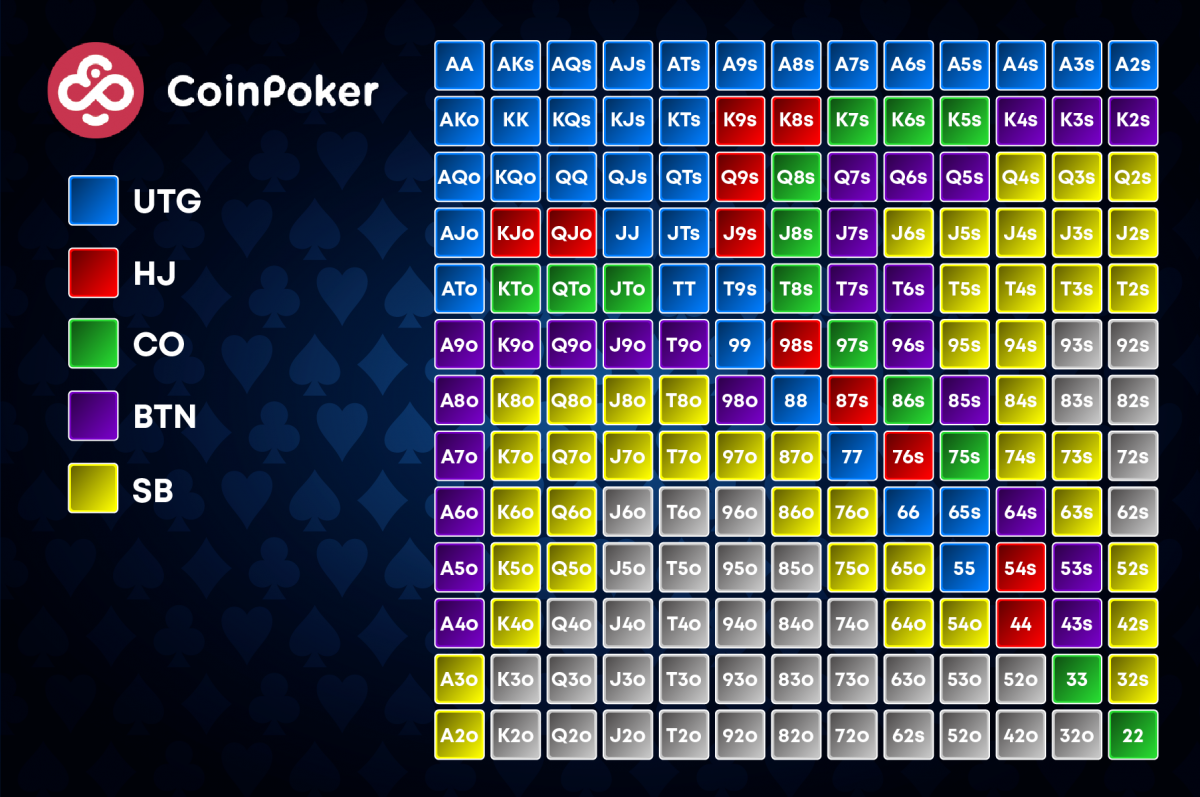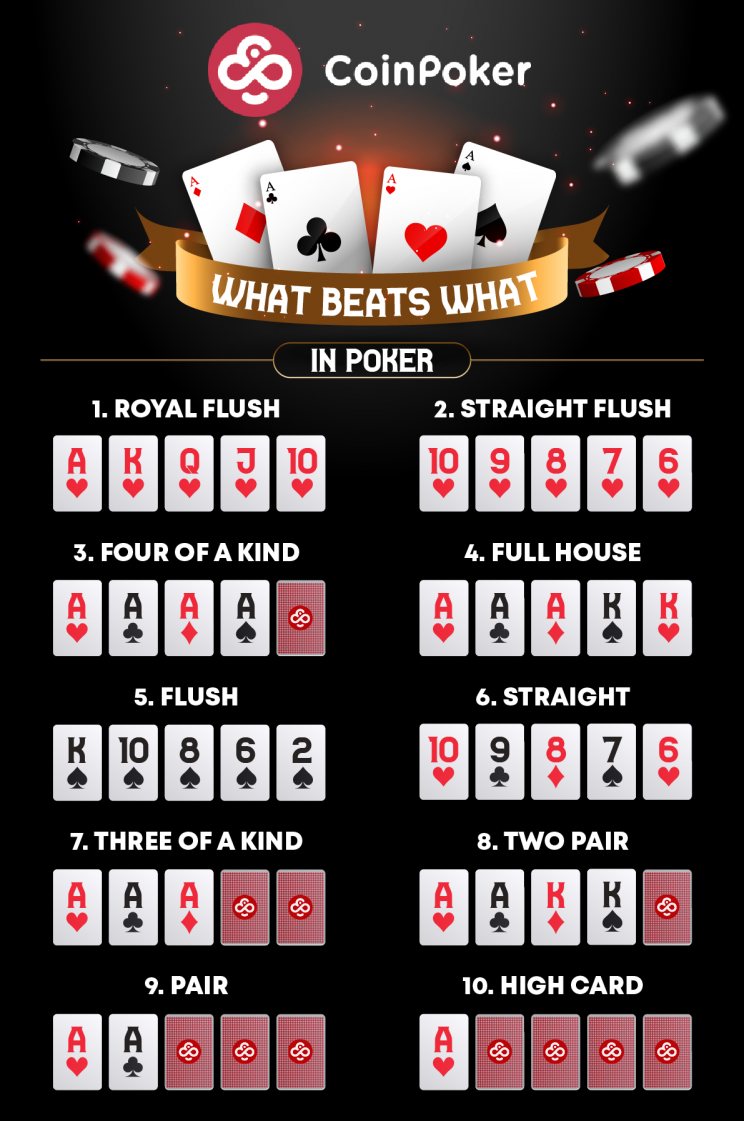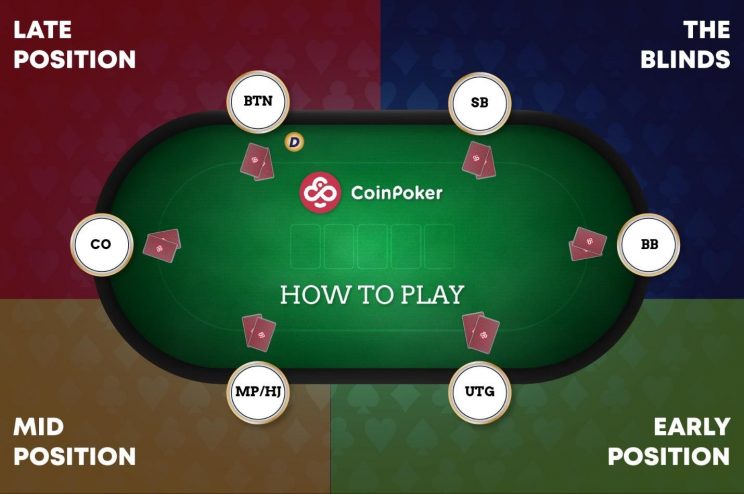
德州扑克新手指南:起手牌图表详解、扑克胜率分析与计算
扑克手牌排名与位置策略
扑克游戏对扑克新手来说可能非常困难,尤其是在对付经验丰富的玩家时。经验丰富的玩家能轻易识别出谁是桌上最缺乏经验的人,并利用这一点来占据优势。
当然,熟悉规则远远不足以在现金游戏中具备竞争力。经验丰富的玩家会根据扑克新手(“鱼”)的游戏风格和他们常做的动作轻松识别出他们。
为了避免这种情况,我们为玩家介绍一些重要的技巧、统计数据、图表和计算策略,希望能够帮助扑克新手。
扑克起手牌排名图表
首先,扑克新手应该了解扑克手牌的排名,从最强到最弱。扑克新手不仅需要知道这些排名,还需要在短短一瞬间识别出获胜的手牌,这对缺乏经验的玩家来说并不容易。
因此,拥有一份手牌排名备忘单对于那些仍需时间来确定自己手牌强度的玩家来说非常有用。为了帮助理解,您可以参考以下的排名图表:

扑克手牌几率 / 牌型几率
那么,组成这些手牌或者是抽到它们的几率是多少呢?让我们来看一下 5 张牌和 7 张牌扑克游戏中的数据。
| 5-card games | 7-card games | |
| Royal flush | 0.00015% | 0.0032% |
| Straight flush | 0.0014% | 0.028% |
| Four of a kind | 0.024% | 0.17% |
| Full house | 0.14% | 2.60% |
| Flush | 0.20% | 3.03% |
| Straight | 0.39% | 4.62% |
| Three of a kind | 2.11% | 4.83% |
| Two pair | 4.75% | 23.5% |
| A pair | 42.3% | 43.8% |
| High card | 50.1% | 17.4% |
在 7 张牌的游戏中,组成这些手牌要容易得多。不过,仍然有一些手牌几乎永远都不会出现,您需要玩成千上万的手牌,才能看到皇家同花顺的出现。这个表格能让您了解哪些手牌在翻牌、转牌和河牌中值得等待,哪些手牌您不应该抱有太大希望。在 7 张牌的游戏中,一对,甚至两对的手牌不太可能获胜,尤其是在满桌上。
德州扑克位置
起始位置在扑克中极为重要。处于早期位置的玩家(即按照出牌顺序最先行动的玩家)通常处于劣势,而处于后期位置的玩家则拥有相对优势。
这是因为后期位置的玩家可以根据其他玩家的行为以及他们在不同阶段的下注情况,获得更多的信息。此外,后期位置的玩家还可以利用某些玩家可能会在自己行动前弃牌的事实,这样他们将面临更少的竞争,甚至可能没有任何竞争。这些因素会影响他们的决策,通常鼓励后期位置的玩家更多地参与手牌,并承担更大的风险。
6人桌位置

扑克位置解析:满桌
在 6-9 人的满桌游戏中,不同位置的术语可能有所不同,但通常使用以下名称来表示各个位置:
- UTG(Under The Gun)
- UTG + 1
- UTG + 2
- 中间位置 1(MP1)或 LoJack(LJ)
- 中间位置 2(MP2)或 Hijack(HJ)
- 中间位置 3(MP3)或 Cutoff(CO)
- 按钮位(BTN)
- 小盲注(SB)
- 大盲注(BB)
德州扑克起手牌图表详解:

在这张图表中,你看到的是德州扑克 6 人桌游戏中所有可能的底牌组合。需要说明的是,“s”表示两张牌是同花的,而“o”表示它们是不同花色的。
这张图表告诉我们应该用哪些底牌组合进行加注,不同的颜色代表不同的起始位置。需要注意的是,每个单独的格子并不代表单一的牌组,而是包含多个组合。例如,KQs 其实有 4 种不同的组合:K♥ Q♥、K♠ Q♠、K♣ Q♣、K♦ Q♦。
对于 KQo 这个格子,可能的手牌组合多达 14 种。总共有 169 个格子,涵盖 1326 种独特的底牌组合。
这张表的前提是,在你行动之前,桌上还没有其他玩家入池。而所有白色的格子意味着你也不应该入池。在这些情况下,通常选择弃牌是更好的决策。对新手玩家来说,这么多弃牌可能会让人感到惊讶,但事实上,用这些底牌赢得牌局的概率非常低。
我们还可以注意到,前位玩家应该更谨慎地加注。例如,UTG(最早行动的玩家)应该只用一个非常紧的范围加注,而按钮位(BTN)的玩家则有更大的加注自由度。因此,BTN 需要用紫色区域的牌加注,同时也可以用绿色、红色和蓝色区域的牌加注。而小盲位的加注范围最广,这是合理的,因为 SB 在开始前已经投入了一部分筹码,如果弃牌就会自动失去这部分钱。
请记住,这张图表不适用于带前注的牌局。如果你玩的是带前注的游戏,就需要使用另一张表格,它会建议你用更宽的范围进行加注。这与小盲位在翻前必须更具攻击性的原因相同——当你已经投入了一些筹码时,放弃一手牌会更加困难。
最后,这张图表并不是一成不变的规则,它只是为玩家提供一个不错的起点,特别是在你对其他玩家没有额外信息的情况下。然而,你的加注策略始终应该取决于桌上其他玩家的激进程度,以及你自己的游戏风格。
奥马哈扑克(PLO)的起手牌选择
然而,你还需要记住,在不同的扑克变体中,决定最佳起手牌的标准可能会有很大的不同。让我们以奥马哈扑克(PLO)为例。
如果你直接使用类似于德州扑克的逻辑,你的判断并不会完全错误。一些高对子组合在 PLO 中依然能够带来很高的底池权益(equity),这并不奇怪。
但需要注意的是,顺子听牌在 PLO 中的价值远远高于德州扑克。这也是合乎逻辑的,因为在 PLO 中,你有 4 张底牌可以搭配,即使最终只能使用其中的 2 张,你仍然拥有更多的连接顺子的机会。因此,像 8、9、10、J 这样的手牌实际上是 PLO 中第 8 强的起手牌,尽管它需要在公共牌中出现 3 张合适的牌才能形成顺子。
底池赔率与胜率分析
底池赔率(Pot Odds)是指翻牌后你的风险回报比,这个比率取决于对手下注的大小以及底池的总额。你需要投入的金额就是你的风险,而底池的大小则是你的潜在回报。
例如,如果你需要投入 $50 进行跟注,而跟注后底池的总额变成 $150,那么你的底池赔率就是 3:1。
你可以使用以下公式将其转换为百分比:
风险/(风险/回报)
你至少需要 25% 的胜率才能让这次跟注在长期上是可行的。
为什么底池赔率很重要?
底池赔率(Pot Odds)在决定是否跟注时非常重要。规则很简单——如果你计算出的胜率(Equity)低于底池赔率对应的百分比,你通常应该弃牌;如果你的胜率高于这个百分比,那么建议跟注。
计算胜率的最快方法是数补牌(outs)。例如:
- 如果你在翻牌圈有 8 张补牌,你的胜率大约是 34%;
- 如果你有 20 张补牌,你的胜率可以高达 86%。
到了转牌圈,如果你没有完成你的手牌,胜率自然会下降,因为只剩最后一张公共牌可用。在这个阶段,每张补牌大约等于 2% 的胜率。
然而,在实战中,要实时计算所有这些数据可能并不容易。因此,可以使用一张表格,将补牌数量转换为权益的估算值。请记住,只有当你的胜率高于底池赔率时,跟注才是合理的选择。
| Number of outs | Number of cards left | |||
| 2 | 1 | |||
| Ratio | Precentage | Ratio | Precentage | |
| 1 | 22.5 : 1 | 4.3% | 46 : 1 | 2.13% |
| 2 | 10.9 : 1 | 8.6% | 22.5 : 1 | 4.26% |
| 3 | 7 : 1 | 12.9% | 14.7 : 1 | 6.38% |
| 4 | 5.1 : 1 | 17.21% | 10.8 : 1 | 8.51% |
| 5 | 3.9 : 1 | 21.51% | 8.4 : 1 | 10.64% |
| 6 | 3.1 : 1 | 25.81% | 6.8 : 1 | 12.77% |
| 7 | 2.6 : 1 | 30.11% | 5.7 : 1 | 14.89% |
| 8 | 2.2 : 1 | 34.41% | 4.9 : 1 | 17.02% |
| 9 | 1.9 : 1 | 38.71% | 4.2: 1 | 19.15% |
| 10 | 1.6 : 1 | 43.02% | 3.7: 1 | 21.28% |
| 11 | 1.4 : 1 | 47.32% | 3.3 : 1 | 23.4% |
| 12 | 1.2 : 1 | 51.62% | 2.9 : 1 | 25.53% |
| 13 | 1.1 : 1 | 55.92% | 2.6 : 1 | 27.66% |
| 14 | 1 : 1 | 60.22% | 2.4 : 1 | 29.79% |
| 15 | 0.9 : 1 | 64.52% | 2.1 : 1 | 31.91% |
| 16 | 0.8 : 1 | 68.83% | 1.9 : 1 | 34.04% |
| 17 | 0.7 : 1 | 73.13% | 1.8 : 1 | 36.17% |
| 18 | 0.6 : 1 | 77.43% | 1.6 : 1 | 38.3% |
| 19 | 0.5: 1 | 81.73% | 1.5 : 1 | 40.43% |
| 20 | 0.5 : 1 | 86.03% | 1.4 : 1 | 42.55% |
如果你能够准确计算你的胜率(Equity)和底池赔率(Pot Odds)的比率,并在较长时间内始终如一地执行这些策略,那么你可以预期在这段时间内获得稳定的盈利。但同时,你还需要关注其他玩家的行动,并尽量推测他们的手牌,以便更准确地评估你的真实权益。
为此,你可以使用各种软件来帮助你计算。你只需输入你的手牌、对其他玩家手牌的最佳估计(可以在游戏过程中不断更新),以及公共牌信息。完成这些输入后,软件将为你提供当前权益的最佳评估。
扑克中最重要的指标
说到扑克软件,请记住,有一些完全合法的软件可以帮助你在在线扑克中获得优势。其中最有用的工具之一,就是那些可以追踪并记录其他玩家的行动,并提供详细分析的软件,让你了解他们的游戏风格和习惯。
为了获得有价值的数据样本,你需要在与某个特定玩家对局时积累足够的手牌数。但如果你能做到,这将非常值得。你不应该对紧凶型玩家做出和激进型玩家相同的决策,而判断你对手的经验水平同样至关重要。
以下是一些关键统计数据,你应该重点关注:
VPIP(Voluntarily Put Money In Pot,自愿投入底池的比例)– 这个数值表示玩家在任何阶段主动投入筹码的百分比,也就是玩家通常参与牌局的手牌范围。VPIP 是衡量玩家风格最可靠的指标之一,可以帮助判断他们是松还是紧。在 6 人桌德州扑克 中,大多数中等水平的玩家 VPIP 约为 20-25%。
PFR(Pre-Flop Raise,翻前加注率)– PFR 代表玩家在翻牌前选择加注的频率。这一指标通常需要与 VPIP 结合使用。如果 VPIP 和 PFR 之间的差距很大,说明该玩家经常平跟入池(limp),而平跟入池几乎总是经验不足的标志。只有休闲玩家才会忽视加注相较于跟注的优势,你可以利用这一点来对付他们。
3bet%(三下注比例)– 这个指标表示玩家在翻牌前选择再加注(三下注)的比例。有经验的玩家 3bet% 一般在 5%-10% 之间。如果某个玩家 3bet 频率过高,往往意味着他们过于激进,有时经验也不足。此外,这些玩家通常使用较宽的范围进行再加注,甚至经常诈唬(Bluff),你可以利用这一点来对抗他们。另一方面,如果你的手牌较弱,不要轻易挑战这类玩家的再加注倾向,可能直接弃牌是更好的选择。
Fold to 3bet(弃牌给3Bet的比率) – 这个指标更简单,它表示玩家在面对 3bet 时选择弃牌的比例。很明显,如果某个玩家面对 3bet 的弃牌率很高,你就应该更频繁地对他们进行再加注,从而施加压力并获得更多底池。
如果你是扑克新手,希望这份小型指南能帮助你更深入地理解扑克的运作方式。这些小技巧和提醒可以作为你的速查表,在玩在线扑克时帮助你做出更快速的反应,并成为你提升扑克技巧的基础。
当然,仅仅依赖这些信息是不够的。你还需要深入学习扑克理论,并积累大量的实战经验,才能掌握那些真正影响胜负的微妙细节。玩得越多,你就越不需要依赖速查表,最终这些知识会融入你的游戏风格。
想要开始积累经验?立即注册 Coinpoker,开启你的扑克之旅吧!

















